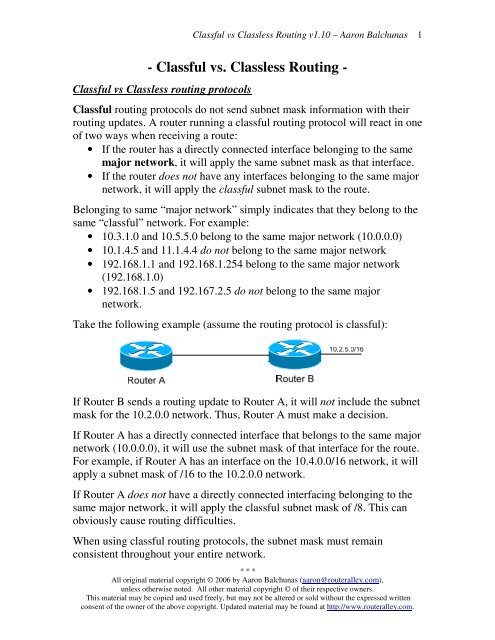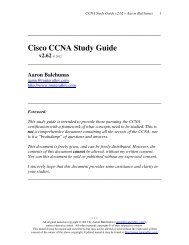Classful vs. Classless Routing - Router Alley
Classful vs. Classless Routing - Router Alley
Classful vs. Classless Routing - Router Alley
You also want an ePaper? Increase the reach of your titles
YUMPU automatically turns print PDFs into web optimized ePapers that Google loves.
<strong>Classful</strong> <strong>vs</strong> <strong>Classless</strong> <strong>Routing</strong> v1.10 – Aaron Balchunas<br />
1<br />
- <strong>Classful</strong> <strong>vs</strong>. <strong>Classless</strong> <strong>Routing</strong> -<br />
<strong>Classful</strong> <strong>vs</strong> <strong>Classless</strong> routing protocols<br />
<strong>Classful</strong> routing protocols do not send subnet mask information with their<br />
routing updates. A router running a classful routing protocol will react in one<br />
of two ways when receiving a route:<br />
• If the router has a directly connected interface belonging to the same<br />
major network, it will apply the same subnet mask as that interface.<br />
• If the router does not have any interfaces belonging to the same major<br />
network, it will apply the classful subnet mask to the route.<br />
Belonging to same “major network” simply indicates that they belong to the<br />
same “classful” network. For example:<br />
• 10.3.1.0 and 10.5.5.0 belong to the same major network (10.0.0.0)<br />
• 10.1.4.5 and 11.1.4.4 do not belong to the same major network<br />
• 192.168.1.1 and 192.168.1.254 belong to the same major network<br />
(192.168.1.0)<br />
• 192.168.1.5 and 192.167.2.5 do not belong to the same major<br />
network.<br />
Take the following example (assume the routing protocol is classful):<br />
If <strong>Router</strong> B sends a routing update to <strong>Router</strong> A, it will not include the subnet<br />
mask for the 10.2.0.0 network. Thus, <strong>Router</strong> A must make a decision.<br />
If <strong>Router</strong> A has a directly connected interface that belongs to the same major<br />
network (10.0.0.0), it will use the subnet mask of that interface for the route.<br />
For example, if <strong>Router</strong> A has an interface on the 10.4.0.0/16 network, it will<br />
apply a subnet mask of /16 to the 10.2.0.0 network.<br />
If <strong>Router</strong> A does not have a directly connected interfacing belonging to the<br />
same major network, it will apply the classful subnet mask of /8. This can<br />
obviously cause routing difficulties.<br />
When using classful routing protocols, the subnet mask must remain<br />
consistent throughout your entire network.<br />
* * *<br />
All original material copyright © 2006 by Aaron Balchunas (aaron@routeralley.com),<br />
unless otherwise noted. All other material copyright © of their respective owners.<br />
This material may be copied and used freely, but may not be altered or sold without the expressed written<br />
consent of the owner of the above copyright. Updated material may be found at http://www.routeralley.com.
<strong>Classful</strong> <strong>vs</strong> <strong>Classless</strong> <strong>Routing</strong> v1.10 – Aaron Balchunas<br />
2<br />
<strong>Classful</strong> <strong>vs</strong> <strong>Classless</strong> routing protocols (continued)<br />
<strong>Classless</strong> routing protocols do send the subnet mask with their updates.<br />
Thus, Variable Length Subnet Masks (VLSMs) are allowed when using<br />
classless routing protocols.<br />
Examples of classful routing protocols include RIPv1 and IGRP.<br />
Examples of classless routing protocols include RIPv2, EIGRP, OSPF, and<br />
IS-IS.<br />
The IP <strong>Classless</strong> Command<br />
The preceding section described how classful and classless protocols differ<br />
when sending routing updates. Additionally, the router itself can operate<br />
either “classfully” or “classlessly” when actually routing data.<br />
When a “classful” router has an interface connected to a major network, it<br />
believes it knows all routes connected to that major network.<br />
For example, a router may have an interface attached to the 10.1.5.0/24<br />
network. It may also have routes from a routing protocol, also for the<br />
10.x.x.x network.<br />
However, if the classful router receives a packet destined for a 10.x.x.x<br />
subnet that is not in the routing table, it will drop that packet, even if there is<br />
a default route.<br />
Again, a classful router believes it knows all possible destinations in a major<br />
network.<br />
To configure your router in “classful” mode:<br />
<strong>Router</strong>(config)# no ip classless<br />
To configure your router in “classless” mode (this is default in IOS 12.0 and<br />
greater):<br />
<strong>Router</strong>(config)# ip classless<br />
(Reference: http://www.cisco.com/en/US/tech/tk365/technologies_tech_note09186a0080094823.shtml)<br />
* * *<br />
All original material copyright © 2006 by Aaron Balchunas (aaron@routeralley.com),<br />
unless otherwise noted. All other material copyright © of their respective owners.<br />
This material may be copied and used freely, but may not be altered or sold without the expressed written<br />
consent of the owner of the above copyright. Updated material may be found at http://www.routeralley.com.
<strong>Classful</strong> <strong>vs</strong> <strong>Classless</strong> <strong>Routing</strong> v1.10 – Aaron Balchunas<br />
3<br />
Limitations of <strong>Classful</strong> <strong>Routing</strong> Example<br />
The following section will illustrate the limitations of classful routing, using<br />
RIPv1 as an example. Consider the following diagram:<br />
This particular scenario will work when using RIPv1, despite the fact that<br />
we’ve subnetted the major 10.0.0.0 network. Notice that the subnets are<br />
contiguous (that is, they belong to the same major network), and use the<br />
same subnet mask.<br />
When <strong>Router</strong> A sends a RIPv1 update to <strong>Router</strong> B via Serial0, it will not<br />
include the subnet mask for the 10.1.0.0 network. However, because the<br />
10.3.0.0 network is in the same major network as the 10.1.0.0 network, it<br />
will not summarize the address. The route entry in the update will simply<br />
state “10.1.0.0”.<br />
<strong>Router</strong> B will accept this routing update, and realize that the interface<br />
receiving the update (Serial0) belongs to the same major network as the<br />
route entry of 10.1.0.0. It will then apply the subnet mask of its Serial0<br />
interface to this route entry.<br />
<strong>Router</strong> C will similarly send an entry for the 10.2.0.0 network to <strong>Router</strong> B.<br />
<strong>Router</strong> B’s routing table will thus look like:<br />
<strong>Router</strong>B# show ip route<br />
Gateway of last resort is not set<br />
C<br />
C<br />
R<br />
R<br />
10.0.0.0/16 is subnetted, 4 subnets<br />
10.3.0.0 is directly connected, Serial0<br />
10.4.0.0 is directly connected, Serial1<br />
10.1.0.0 [120/1] via 10.3.5.1, 00:00:00, Serial0<br />
10.2.0.0 [120/1] via 10.4.5.1, 00:00:00, Serial1<br />
* * *<br />
All original material copyright © 2006 by Aaron Balchunas (aaron@routeralley.com),<br />
unless otherwise noted. All other material copyright © of their respective owners.<br />
This material may be copied and used freely, but may not be altered or sold without the expressed written<br />
consent of the owner of the above copyright. Updated material may be found at http://www.routeralley.com.
<strong>Classful</strong> <strong>vs</strong> <strong>Classless</strong> <strong>Routing</strong> v1.10 – Aaron Balchunas<br />
4<br />
Limitations of <strong>Classful</strong> <strong>Routing</strong> Example<br />
Consider the following, slightly altered, example:<br />
We’ll assume that RIPv1 is configured correctly on all routers. Notice that<br />
our networks are no longer contiguous. Both <strong>Router</strong> A and <strong>Router</strong> C contain<br />
subnets of the 10.0.0.0 major network (10.1.0.0 and 10.2.0.0 respectively).<br />
Separating these networks now are two Class C subnets (192.168.123.0 and<br />
192.168.111.0).<br />
Why is this a problem? Again, when <strong>Router</strong> A sends a RIPv1 update to<br />
<strong>Router</strong> B via Serial, it will not include the subnet mask for the 10.1.0.0<br />
network. Instead, <strong>Router</strong> A will consider itself a border router, as the<br />
10.1.0.0 and 192.168.123.0 networks do not belong to the same major<br />
network. <strong>Router</strong> A will summarize the 10.1.0.0/16 network to its classful<br />
boundary of 10.0.0.0/8.<br />
<strong>Router</strong> B will accept this routing update, and realize that it does not have a<br />
directly connected interface in the 10.x.x.x scheme. Thus, it has no subnet<br />
mask to apply to this route. Because of this, <strong>Router</strong> B will install the<br />
summarized 10.0.0.0 route into its routing table.<br />
<strong>Router</strong> C, similarly, will consider itself a border router between networks<br />
10.2.0.0 and 192.168.111.0. Thus, <strong>Router</strong> C will also send a summarized<br />
10.0.0.0 route to <strong>Router</strong> B.<br />
* * *<br />
All original material copyright © 2006 by Aaron Balchunas (aaron@routeralley.com),<br />
unless otherwise noted. All other material copyright © of their respective owners.<br />
This material may be copied and used freely, but may not be altered or sold without the expressed written<br />
consent of the owner of the above copyright. Updated material may be found at http://www.routeralley.com.
<strong>Classful</strong> <strong>vs</strong> <strong>Classless</strong> <strong>Routing</strong> v1.10 – Aaron Balchunas<br />
5<br />
Limitations of <strong>Classful</strong> <strong>Routing</strong> Example<br />
<strong>Router</strong> B’s routing table will then look like:<br />
<strong>Router</strong>B# show ip route<br />
Gateway of last resort is not set<br />
C<br />
C<br />
R<br />
192.168.123.0 is directly connected, Serial0<br />
192.168.111.0 is directly connected, Serial1<br />
10.0.0.0 [120/1] via 192.168.123.1, 00:00:00, Serial0<br />
[120/1] via 192.168.111.2, 00:00:00, Serial1<br />
That’s right, <strong>Router</strong> B now has two equal metric routes to get to the<br />
summarized 10.0.0.0 network, one through <strong>Router</strong> A and the other through<br />
<strong>Router</strong> C. <strong>Router</strong> B will now load balance all traffic to any 10.x.x.x network<br />
between routers A and C. Suffice to say, this is not a good thing. ☺<br />
It gets better. <strong>Router</strong> B then tries to send routing updates to <strong>Router</strong> A and<br />
<strong>Router</strong> C, including the summary route of 10.0.0.0/8. <strong>Router</strong> A’s routing<br />
table looks like:<br />
<strong>Router</strong>A# show ip route<br />
Gateway of last resort is not set<br />
C<br />
C<br />
192.168.123.0 is directly connected, Serial0<br />
10.0.0.0/16 is subnetted, 1 subnet<br />
10.1.0.0 is directly connected, Ethernet0<br />
<strong>Router</strong> A will receive the summarized 10.0.0.0/8 route from <strong>Router</strong> B, and<br />
will reject it. This is because it already has the summary network of 10.0.0.0<br />
in its routing table, and it’s directly connected. <strong>Router</strong> C will respond<br />
exactly the same, and the 10.1.0.0/16 and 10.2.0.0/16 networks will never be<br />
able to communicate.<br />
* * *<br />
All original material copyright © 2006 by Aaron Balchunas (aaron@routeralley.com),<br />
unless otherwise noted. All other material copyright © of their respective owners.<br />
This material may be copied and used freely, but may not be altered or sold without the expressed written<br />
consent of the owner of the above copyright. Updated material may be found at http://www.routeralley.com.

















